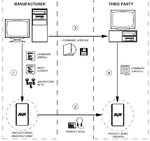vinodstanur
Advanced Member level 3
- Joined
- Oct 31, 2009
- Messages
- 751
- Helped
- 114
- Reputation
- 234
- Reaction score
- 114
- Trophy points
- 1,333
- Location
- Kerala (INDIA)
- Activity points
- 7,054
Hi,
I want to update code in avr using a serial bootloader but at the same time want to protect the code so that no one can read it...
In such case what can I do?
I want to update code in avr using a serial bootloader but at the same time want to protect the code so that no one can read it...
In such case what can I do?
